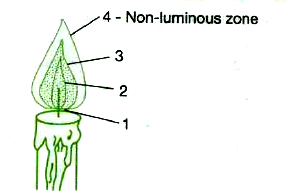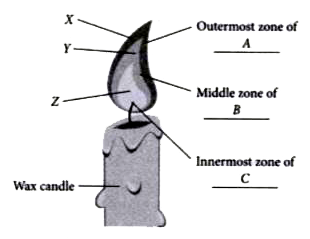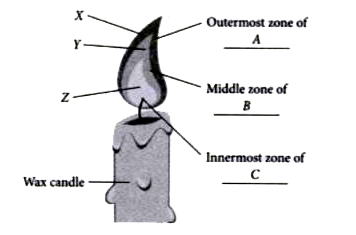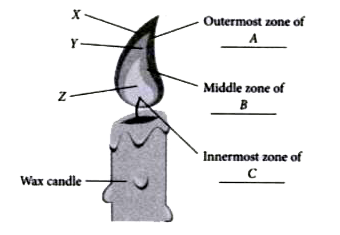Middle zone is the hottest zone of a flame.
Step-by-Step Solution:
1. Understanding Flame Structure: A flame consists of different zones, each with varying temperatures and characteristics. The main zones are the outer zone, the middle zone, and the inner zone.
2. Identifying the Middle Zone: The middle zone of a flame is often described as having a bluish color. This zone is typically where some combustion occurs but is not the hottest part of the flame.
3. Identifying the Outer Zone: The outer zone of the flame is characterized by a red color and is where complete combustion takes place. This zone is the hottest part of the flame due to the presence of sufficient oxygen, which allows for complete burning of the fuel.
4. Understanding Combustion: Combustion is the process of burning a substance in the presence of air (oxygen). Complete combustion results in the release of heat and light, which is visible as the flame.
5. Conclusion: The statement "Middle zone is the hottest zone of a flame" is incorrect. The hottest zone of a flame is actually the outer zone, where complete combustion occurs.
6. Final Statement: Therefore, we can conclude that the hottest region of a flame is the outermost region, not the middle zone.
---
Topper's Solved these Questions
- COMBUSTION AND FLAME BOOK - NCERT EXEMPLARCHAPTER - COMBUSTION AND FLAME EXERCISE - LONG ANSWER QUESTIONS
7 Videos
- COMBUSTION AND FLAME BOOK - NCERT EXEMPLARCHAPTER - COMBUSTION AND FLAME EXERCISE - SHORT ANSWER QUESTIONS
12 Videos
- COAL AND PETROLEUMBOOK - NCERT EXEMPLARCHAPTER - COAL AND PETROLEUMEXERCISE - LONG ANSWER QUESTIONS
9 Videos
- CONSERVATION OF PLANTS AND ANIMALS BOOK - NCERT EXEMPLARCHAPTER - CONSERVATION OF PLANTS AND ANIMALS EXERCISE - LONG ANSWER QUESTIONS
3 Videos
Similar Questions
The water heated by Ramesh will get heated in a shorter time because he kept his beaker near the hottest zone of the flame. Comment.
View SolutionIn order to melt metals such as gold and silver, goldsmiths blow the outermost zone of a flame towards the gold or silver using a metallic blow-pipe.
Why is the outermost zone of the flame blown towards the gold or silver?
View Solution
Knowledge Check
Which of the following statements are true?
I. In the luminous zone of candle flame, vaporised wax gets oxidised to carbon dioxide which burns with a blue flame.
II. There is no burning in the dark inner zone of the flame.
III. Non luminous zone is the hottest part of the flame.
IV. Luminous zone of a flame is mainly due to incomplete burning of carbon.AI and III onlyBII and III onlyCII, III and IV onlyDAll of theseWhich is the hottest part of the flame?
ABlue zoneBzone of partial combustionCzone of complete combustionDzone of no combustionA flame is the visible gaseous part of a fire. It is a zone of combustion of gaseous substances accompanied by evolution of heat and light. All substances do not burn with a flame. Only those substances that vaporise during burning produce flame. A candle flame is taken to study the various zones of a flame.

Different zones of a candle flame are marked by the letters (A), (B) and (C).
Which of the following statements are correct?
(I) (B) is the hottest part of the flame.
(II) (C) is moderately hot.
(III) (A) is the hottest part of the flame.
(IV) (A) is moderately hot whereas (C) is the coldest part.
(V) (C) is the luminous zone.
(VI) (B) is the luminous zone.
(VII) (A) is the dark zone.A(III), (V) and (VII)B(III) and (VI)C(I), (IV) and (VI)DAll of these
In order to understand the structure of a flame, light a wax candle and watch its flame. Carefully note the different coloured zones in the flame. Starting from the base of the flame, a flame has three zones. Check the below figure and try to answer the following question

Expalin why dark zone is the coldest part of a candle flame.
View SolutionA flame is the visible gaseous part of a fire. It is a zone of combustion of gaseous substances accompanied by evolution of heat and light. All substances do not burn with a flame. Only those substances that vaporise during burning produce flame. A candle flame is taken to study the various zones of a flame.

Which zone of a candle flame is the zone of no combustion?
View SolutionA flame is the visible gaseous part of a fire. It is a zone of combustion of gaseous substances accompanied by evolution of heat and light. All substances do not burn with a flame. Only those substances that vaporise during burning produce flame. A candle flame is taken to study the various zones of a flame.

The luminous and non-luminous zones of flame is respectively.
View SolutionA flame is the visible gaseous part of a fire. It is a zone of combustion of gaseous substances accompanied by evolution of heat and light. All substances do not burn with a flame. Only those substances that vaporise during burning produce flame. A candle flame is taken to study the various zones of a flame.

(A), (B) and (C) are respectively.
View SolutionA flame is the visible gaseous part of a fire. It is a zone of combustion of gaseous substances accompanied by evolution of heat and light. All substances do not burn with a flame. Only those substances that vaporise during burning produce flame. A candle flame is taken to study the various zones of a flame.

Arrange X, Y and Z in increasing order of temperature.
View Solution
